

|
About the Flame Boxes:
This project was not constructed for Halloween use, but would certainly be a creepy prop to be used for a home-haunt. I designed he following boxes to simulate a beach fire for a Beach Boys concert that my employer hosted in 1995. The visual effects from the fire are hard to capture in still-photographs, but rest assured that they look real in the darkness. As a matter of fact, I was told that someone tried to throw water on one at the concert because they thought it was a real fire!
Note: The flame boxes in this project were constructed to be "heavy duty" versions. They were designed to be placed outside atop a sand pile and to be run for many hours. If you are not planning on using your flame box for long periods, you may want to simplify the construction in order to keep the cost down. It may not be necessary for the average person to construct the heavy wooden frame that is shown below, but full instructions are given anyway.
|
Material List:
Box fan (can be purchased for around $10 at Wal-Mart), 1 yard of both orange and yellow Costume Material (purchased in Wal-Mart fabric dept. for under $5), 1 floodlight and fixture.
Assorted scrap lumber: 2"x2" boards, misc. pieces of plywood, an d scrap tin sheeting or termite shield.
Tools: cordless drill, nails or drywall screws, hammer, tinsnips, some type of saw.
|

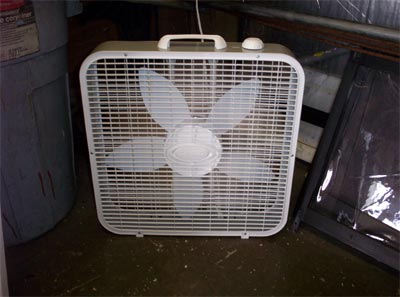
| Step 1:
Here is a shot of the box fan that was used. After purchasing the fan, take measurements to determine the size of frame that you will need to build.
|

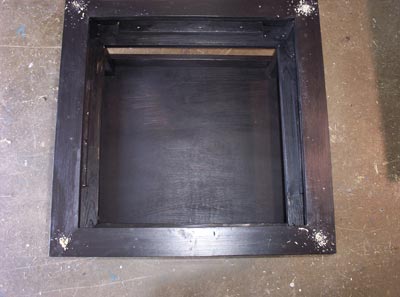
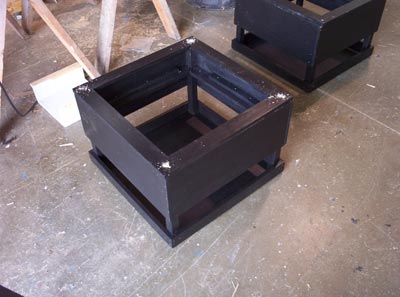
| Step 2:
Using either scrap or new lumber, construct a box to house the fan and paint it black. Since the dimensions or the box will differ depending on the size of the fan, exact measurements are not given. Take notice of the small "lip" inside the box which supports the fan.
These boxes were built on a solid base and have a ledge that encircles the bottom. These elements were necessary in order to keep the sand away from the fan. If you don't intend on placing your flame-box in sand, you could leave the base off of the design.
You can download a printable PDF drawing (460k) of the plans by clicking here. These plans will help give you a better idea of the box construction. Remember, this PDF drawing is my original sketch and modifications to the design were made and shown in detail below.
I am not a carpenter, and I have to give a lot of credit to Steve, our maintenance man for actually constructing the boxes! They were perfectly constructed.
|

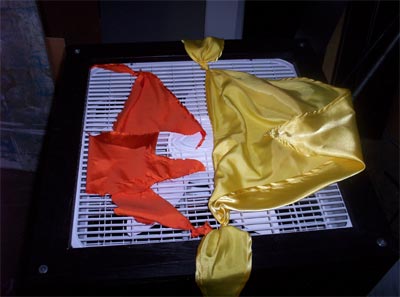
| Step 3:
Place the fan into the box frame and secure it . We made a top frame that screwed into the box, locking the fan into position. Make sure the fan is blowing the air UPWARDS.
Step 4:
Cut the costume material into the desired shapes. I cut the larger yellow flame into a single triangle, and the smaller orange on into a double triangle (like two upside down ""V's"). Hem the edges to keep the material from fraying.
Step 5:
Tie the fabric onto the grill of the box-fan. Make sure to leave quite a bit of space between them to give them "flapping room." At this point, you will want to turn the fan on and see the effect. If your fan is powerful enough to keep the fabric in the air indefinitely, then you can skip the steps involving the sheet metal described below. Unfortunately, my fan was such a wussy, that I had to install the metal deflectors shown below in order to add air pressure to the fan.
|

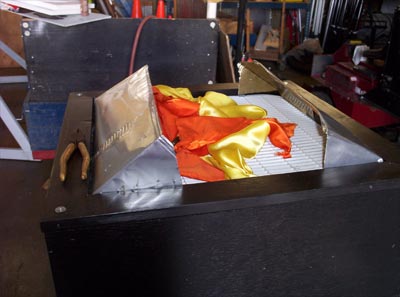
| Step 6:
Using scrap tin, duct work, or termite shield, make and attach an air deflector to the box's frame. Be careful! The edges will be sharp!!!! To make them a bit safer, I covered all of the exposed edges with a layer or two of duct tape.
|


| Step 7:
Cut a "U" out of one of the air deflectors. This "U" will help hold the flood light in place, so make sure that the cut out area is large enough to stitch the base of the light bulb trough it.
|

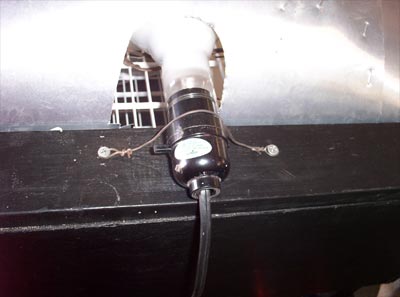
| Step 8:
Attach the floodlight and fixture to the box frame. I used a wire and two drywall screws to hold the fixture in place.
|

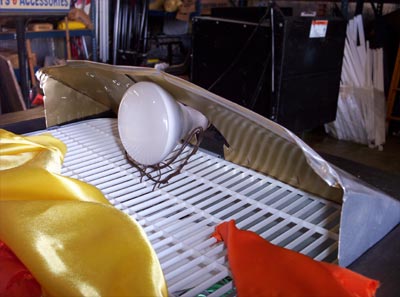
| Step 9:
Make a wire frame for the inside to keep the bulb from touching the fan's plastic grill. This doesn't have to be pretty because no one else will see it. Its always better to use too much wire than not enough and have a risk of fire.
|

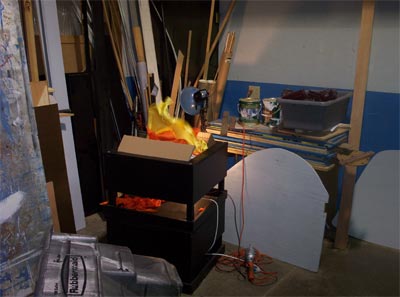
| Step 10:
Plug both fan and light to an outlet and watch the flames dance. If things work as you like, cover the fabric with some cardboard and paint the air deflectors black to match the wooden box.
|

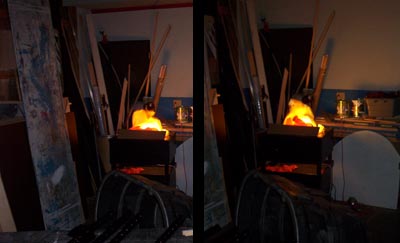
| The Finished Product:
Two shots showing how the light makes the fabric appear to be real flames. These shots were taken in a garage during the middle of the day! Just image how they look in the darkness!!!! Your Flame Box is complete.
|

What do you think? Contact me and let me know by clicking here.
|



















